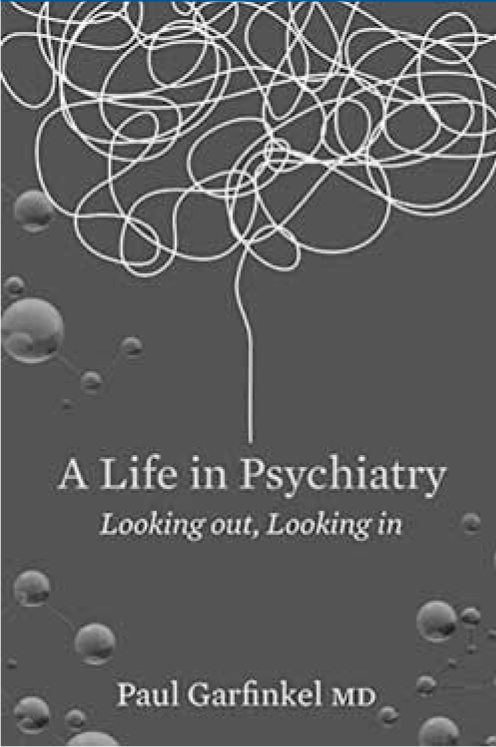
For a psychiatrist to write an autobiography is a rare event. Professor Paul Garfinkel is a Canadian psychiatrist who has spent most of his professional life in Toronto. His account is presented in chronological order, beginning with information about his background and containing, to a degree, key self-revelations. For example, he felt he had been overprotected by his upbringing, within the cocoon of his Jewish family. He experienced prolonged grief after the deaths of his parents. He admits to a tendency to lose his temper when he thinks someone else is bent on personal gain.
He divides his 40-year career into two phases. During the first part he saw himself as a clinical psychiatrist with strong academic leanings. Indeed, his research was distinguished by key papers on the raised prevalence of anorexia nervosa among student dancers and fashion models, whose occupations entailed pressures to maintain a thin body shape. He also established through cohort studies that the historical period when these social pressures first appeared was from the late 1960s onwards. The second phase of his career was spent leading institutions at the forefront of the mental health revolution in Canada. He became more interested in management and executive leadership than the psychiatric issues reported in the profession's journals.
In 1986, Garfinkel experienced the ‘biggest crisis’ of his career. His closest research colleague was accused by a female patient of having had a sexual relationship. After a while Garfinkel could no longer accept his colleague's denials, and felt betrayed. He sought to understand why such professional lapses occurred. He reviewed the literature, and found that between 6 and 10% of psychiatrists succumb to what he calls ‘the slippery slope phenomenon’. He names several senior psychiatrists in Ontario guilty of such sexual transgressions. He also commits himself strongly against other colleagues who seek ‘excessive emoluments’ from drug companies for assisting in drug trials. They too are named in the book. In the foreword there is a sensitively written section by Dr David Goldbloom cautioning the reader against concluding that part of Garfinkel's character is to be judgemental.
It is uncommon for clinical researchers to welcome having an additional managerial role. During the second part of his career Garfinkel chose to take on this role increasingly. He explains this new motivation by what he saw when regularly driving past the Queen Street Mental Health Centre on the site of the old Toronto asylum – homeless people who were clearly ill, talking to themselves or pushing grocery carts filled with their belongings. He sensed that these were people with the most serious psychiatric illnesses, living on the streets. Yet the medical profession was not taking care of them. Here was a sign of the gap between scientific achievements and society's level of care. He quotes a 2004 survey in which it was found that only a third of people who needed psychiatric care succeeded in obtaining it. Queen Street Hospital had low staffing levels of psychiatrists, in contrast with the well-endowed Clarke Institute, where Garfinkel held his Chair, and the Toronto General Hospital where there were good psychiatric facilities. After this conversion experience he developed a fresh ideology, encapsulated in his phrase ‘research, education, health promotion and care are mutually enhancing’.
Garfinkel played a central part during a merger of the most significant mental health facilities in Toronto: the Clarke Institute, the Toronto General Hospital and the Addiction and Mental Health Services Corporation. He accepted the post of Chief Executive Officer for the Centre for Addiction and Mental Health. He made good use of his capacity for hard work and attention to detail including ways of reaching the hearts and minds of his more reluctant colleagues. Some of them became resentful because of changes to their roles. He felt he was becoming increasingly isolated as the influential leader of the Centre.
Unusual in an autobiography, the book has a strong educational content. For example, any psychiatrist faced with the task of planning a mental health merger would do well to follow the author's advice on the logistics and the psychological problems that have to be overcome. The book also contains pearls of clinical wisdom. Garfinkel commits himself to a return to the psychiatric formulation as opposed to the narrower diagnostic procedure of following the DSM-5 criteria. His chapter on ‘DSM dysfunction’ is an insightful account of limitations of this DSM approach, including false multiplication of psychiatric disorders. Equally important, teaching of psychiatry has become distorted, leading trainees to diagnosing psychiatric illness by using the DSM checklists.
Professor Garfinkel ends his autobiography in a dramatic manner but, in order not to spoil his story, this reviewer will not disclose the ending. This most interesting book will repay detailed reading, made easy by the author's pleasing narrative style.



eLetters
No eLetters have been published for this article.